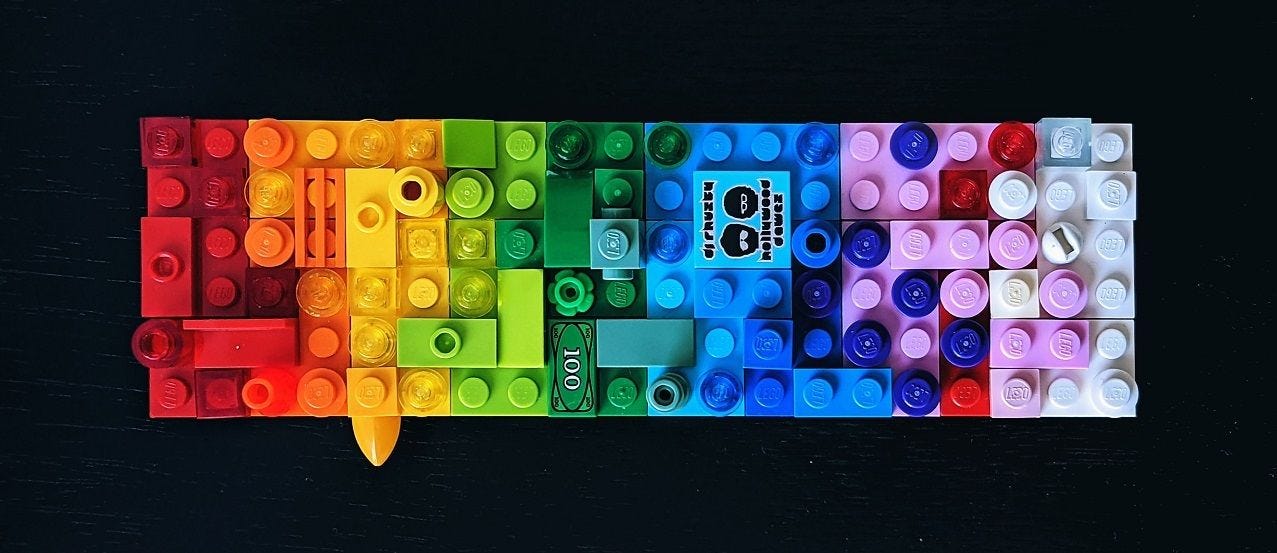What about people who are happy they transitioned?
What I’m interested in isn’t trans people per se, it’s the notion that some men can “really be women” and what that does to societal rules
I’m sometimes asked why I don’t talk about people for whom transition was the best option. I give part of the answer in my book—that what I’m interested in isn’t trans people per se, it’s the ideology that underpins the notion that some men can “really be women” and vice versa, and the impact of that ideology on society at large, which I think is wholly negative. In this issue I’m going to elaborate on that answer. I’ll explain why I think a common framing is mistaken—that for some people, at least, transition is the best option and all that is needed is to identify them accurately; and why anyone who cares about sex-based rights should want fewer people to believe in gender-identity ideology, and fewer people to transition.
Let’s start by imagining three archetypal transitioners. First, a small child (let’s make him a boy, since early gender dysphoria affects boys more than girls). Second, a teenager (let’s make her a girl, and note that this is the group that’s been flooding into gender clinics since around 2015). Finally, someone well into adulthood (I’ll make him a man, since the origins of gender medicine lie in adult men who desire to be women).
I’ll talk first about what “transition” means for each of these three people, and then about what it means for everyone else.
For our little boy, it’s very easy to “pass” as a girl: his parents just change his name, hairstyle and pronouns. If you don’t work through the logical consequences—and many parents who transition their children clearly don’t—that may seem like the end of the matter. But precisely because he passes so easily, the temptation is for his family to lie to everyone else. And that leads to some very nasty places.
For a start, it deprives the child of the chance to learn to accept the unalterable fact that he is male and to love himself as he is. The need to keep up the pretence means keeping other people at a distance from the family—and teaching the child to distance himself from his physical reality. What if he’s invited to a girls-only sleepover? What if he wants to do ballet, or swimming, or gymnastics? Parents end up inventing excuses to explain away the fact that their “daughter” never stays at friends’ houses—or buying “tucking underpants” to flatten his genitals so he can wear a swimsuit or leotard. What better way to convince a boy that he and his body are somehow different and shameful, and that others would hate and despise him if they knew the truth?
And social transition leads with disturbing inevitability to medical transition: to puberty blockers, cross-sex hormones and surgeries. (Incredibly, this very foreclosing of future options was recently cited as evidence of the extraordinary accuracy of paediatric gender medicine, in an academic paper that has been carefully debunked by one of my favourite Substackers, “Void if Removed”.) The impact of puberty blockers on brains and bones is not known for certain, largely because those who prescribe them are invested in not finding out, but is unlikely to be good. The impact on the reproductive system is clearer—and potentially dire. If a child starts puberty blockers early and progresses straight to cross-sex hormones, the result will be sterility and anorgasmia.
Now let’s turn to our teenage girl. Of our three archetypes, she’s the one most obviously caught up in a social contagion: before the past decade paediatric gender clinics almost never saw this group, and now it predominates everywhere that gender medicine is practised. Gender clinics are disgracefully bad at collecting data, but what we do know is that these girls have many comorbidities (co-occurring medical conditions): self-harm, eating disorders, depression, anxiety, obsessive-compulsive disorders and autistic traits.
Even so, because they are at or near the age of consent, the lack of gatekeeping in paediatric gender medicine means they are often able to access drugs and surgeries while still minors. These include mastectomies and testosterone, and the changes are irreversible. These girls, too, are being denied the chance to learn to love themselves as they are. And the longer they take testosterone the more their fertility will be compromised. Even if they do not have their uterus and ovaries removed, male hormones cause uterine pain and atrophy. Many, many teenage girls think that they will never want to have children, only to realise later that they very much do.
When you make the details of paediatric transition specific and personal like this, it’s clear—at least to me—that the harms are so large that no minor should be allowed to go down this path. My reasoning does not depend only on the fact that in most cases the gender dysphoria would resolve naturally if they were never “affirmed” in their denial of their sex, although there is plenty of evidence that that is true for the little boys. And the role of social contagion makes it very likely for the teenage girls (we don’t know for sure because they are such a recent phenomenon).
No, the central problem with paediatric gender medicine is not that we have no way of telling who will persist and who will desist. It’s that the very concept of foreclosing important aspects of someone’s life while they are still a child is outrageous. No pre-pubescent child, no matter how gender-dysphoric, should be sterilised and denied a happy future sex life before they can possibly comprehend what that means. No pre-pubescent child should have their brain and bone development compromised. As for the teenagers, the element of social contagion suggests that they will experience regret most often, and most quickly. But even those who don’t end up regretting will have been harmed in ways that no minor should be.
I’m afraid it may take another couple of decades before this medical scandal is all played out. But I’m pretty sure that the damage will eventually become too widespread and obvious to ignore. The only question is how long it will take, and how many children will have been irrevocably harmed by the time it does. Obviously—obviously—I want that number to be as low as possible. Anyone who cares about child welfare and safeguarding should.
Now, finally, let’s consider our adult man. For someone in this situation, the calculation of personal costs and benefits is less clear than it is for children. Preserving fertility may be of less concern than when making decisions for a minor. He may already have children or be settled in the knowledge that he does not want them—or, indeed, have no intention of having his baby-making equipment removed. Taking oestrogen probably isn’t hugely healthy for him, but at least his brain and bones are already mature.
The irreversible effects of pubertal testosterone may make it impossible for him to pass (indeed, enabling boys to pass as women in adulthood is one of the main arguments put forward by proponents of paediatric transitioning). For one man this may be a major factor in deciding against transition; for another it may be irrelevant, either because he doesn’t actually care about passing, or because he mistakenly thinks he does pass. In this dialogue between transwoman Robin Moira White and philosopher Kathleen Stock in Prospect magazine, for example, White accepts having a deep masculine voice—an asset for a barrister who wants to convey authority—despite that voice making it impossible to pass. As for self-delusion about passing as a woman, Naomi Cunningham (a barrister who effortlessly exudes gravitas with no need for bass tones) explains how and why that might develop here.
Most people who identify as trans never undergo any sort of medical treatment, let alone genital surgery. But for some, gender dysphoria has been so long-standing and crippling that it seems likely never to ease, and surgery may seem like their best option. I know some transwomen who have undergone it and are content with the results. I wish they hadn’t felt they needed such drastic treatment to have a shot at happiness—and I’m pretty sure that at least some would never have developed gender dysphoria if the world had treated their early, extreme gender non-conformity more kindly. But while we work towards that better world, there are people suffering now. And I don’t blame individuals for doing what they feel they must to cope with the one life they have.
Overall, the most important thing to remember about this imagined individual’s personal cost-benefit calculation is that he is an adult. We can assume that he is reasonably settled in his beliefs and desires, and capable of weighing risks and benefits according to his own lights. If he is fully informed of those risks (a big if, given how politicised gender medicine has become), personal autonomy and choice are much more justified guiding principles than they would be for a minor.
Is that it, then? Personal choice, autonomy, live and let live and that’s all there is to say when it comes to adults? That’s certainly the impression I often get when I’m invited on radio or TV, even with interviewers who have read and admired my book. There’s a sort of throat-clearing that precedes our discussion on the story of the day: no one here is a transphobe; if a man wants to live as a woman, or a woman wants to live as a man, fair play to them; it’s no one else’s business.
And then we move on to whatever has happened that has inspired them to invite me on—and it demonstrates precisely why personal choice and autonomy offer such a poor framework for calculating the costs of transition beyond the individual. In other words, the story of the day is inevitably one which shows what one person “living as a man” or “living as a woman” means for everybody else.
When Einar Wegener (Lili Elbe, pictured above) sought to “live as a woman” back in the 1920s, it was because he wanted to wear dresses and makeup; to dance with, kiss and marry a man; to be protected by “that sterner being, the husband”. But nowadays, men and women can vote, own property, get an education and enter the professions on an equal footing. Pensionable ages have been equalised and anyone can marry someone of either sex. Although homophobia is still disturbingly common, in big, liberal cities you can wear what you like and call yourself what you like, and nobody will look at you twice.
Nowadays, as far as law and public policy are concerned, the only distinctions between the sexes are when sex irreducibly matters. And so the only thing left for “living as a man” or “living as a woman” to mean is gaining access to spaces and services that are meant exclusively for the sex you are not. As I say in my book, gender self-identification “is a misnomer. It is actually about requiring others to identify you as a member of the sex you proclaim.”
And that makes it a problem for society at large, and particularly for women, who need single-sex spaces and services more than men do. Every trans-identified man who feels entitled to use women’s facilities is making those spaces less comfortable and less safe for all women. This particular man who is “living as a woman” may not be a rapist, flasher or Peeping Tom—most men aren’t—but how are women supposed to know he is safe? Moreover, when some obviously male people gain entry to female facilities, it becomes unfeasible to keep out any males. And how can a woman ask a male interloper whether he identifies sincerely as a woman? Given men’s greater strength and the evident fact that this is a man who is willing to ignore women’s boundaries, how could she dare?
It doesn’t take many people using facilities for the opposite sex to destroy them for everyone. Just one male person who feels entitled to use female toilets can make those facilities out of bounds for any woman who crosses his path—at work, at the gym, in train stations and shopping centres, in bars, pubs and nightclubs. The impact is similarly disproportionate in other places where women’s rights depend on keeping all men out. One trans-identified man can destroy an entire female sporting competition. One trans-identified man in a women’s prison destroys all the female inmates’ peace of mind—and worse. One trans-identified man in a rape-crisis centre—or running it—will cause many women in great need of its services to self-exclude.
Also dangerous for sex-based rights are people who aren’t trans-identified, but subscribe to gender-identity ideology. They, too, cause problems for everyone else by pushing the sex-denialism that lies at its core.
They include people who make absurd claims, for example that the purpose of women’s sport is to protect men’s fragile egos, as in this idiotic Twitter thread by Sheree Bekker (she/her), an assistant professor at Bath University. The sporting officials who are allowing trans-identified males to identify into female competitions as long as they suppress their testosterone. The charity workers so delighted with their own virtue-signalling that they insist all rape-crisis services must be open to men who identify as women. The employees in human resources who impose preferred pronouns and gender-neutral toilets across their organisations, in the name of “inclusivity”. The Silicon Valley programmers who write software to pick up and delete “misgendering” on social media. The school bullies who harass classmates because they dare to ask questions about trans issues. The academics who publicly denounce colleagues who argue for sex-based rights (here’s an open letter about Kathleen Stock; here’s another about Jo Phoenix).
All in all, the more people there are who insist that everyone else treats them as members of the sex they are not, and the more “allies” they have who promote the doctrine of sex-denialism, the worse public life is for everyone else. It’s not just that sex-based rights become impossible to enforce, either. A lot of other things are damaged, too. These include lawmaking, sound public policy, scientific rigour, medical ethics, academic standards and free speech. Anyone who cares about these things should want as few people identifying as trans, and as few “allies” denying the reality and salience of sex, as possible.
You may have seen me described as a genocidaire or eugenicist in recent days for pointing this out! But obviously I advocate neither murdering nor sterilising anyone. Indeed, in the sort of irony I’ve become well used to, the people denouncing me most furiously are the very ones promoting paediatric transition, which sterilises children.
No, my path back to a sane world—that is, one where everyone accepts the reality and salience of sex in law and everyday life—has three boringly sensible and rights-enhancing steps.
The first, as I say above, is ending paediatric transition. The second is reasserting the meaning of sex everywhere that the sexes are separated in public life. This doesn’t mean intruding on other people’s rights to practise sex-denialism; it just means they have to do it in their private life, like believers in any other religion. If someone wants to transition in some personal sense, whether that means dressing unconventionally for their sex, convincing their friends and family to call them by different pronouns, or having surgery, they can go right ahead. If Emily Bridges and Lia Thomas had identified as women in their own circles but continued to compete in men’s events, I’d be right there cheering them along.
This is a standard liberal argument: that one person’s liberty to swing his fist ends where the other person’s nose begins. But I also think that if it became clear that while you could identify as whatever gender (or indeed anything else) you liked in your private life, your self-identification would make no difference to your rights in public places, fewer people would transition. The very idea of identifying as a member of the opposite sex is specific to modern, Western culture; in most of the world, and throughout history, it would have made no sense. It is ridiculously naïve to think that the spread of this idea has not encouraged trans identification, or to think that a return to sex-realism in the public square would not discourage it.
My final step would be to make it easier to talk about all this. A woman really should not have to cope with being called genocidal because she says men should stop identifying into women’s spaces, and doctors should stop sterilising children. And making these arguments is so much harder when you’re forced to use female words like “girl”, “woman” and “she” for trans-identified boys and men, and male words for trans-identified girls and women.
But the main reason for taking back control of our language and speech is that linguistic trickery is essential to the absurd and dangerous misrepresentations I’m currently experiencing. Only if you concretise the invented cis/trans binary and erase the real male/female one can you even pretend to think that the path to a world with “fewer trans people” is mass slaughter. You have to argue, despite all the evidence that “trans” is an invented category unknown outside modern Western societies, that it is innate, immutable and eternal, while that of “female” is either non-existent or irrelevant. (To grasp the full outrageousness of this reversal, remember that we actually do have “fewer female people” in the world than we should, because of sex-selective abortion, female infanticide and other horrific forms of woman-hatred. But until recently nobody at all was trans-identified, and in most places that is still the case.)
I don’t think returning societal rules and norms to sex-realism will be easy. Too many people have been told by too many authorities that their gender identities override other people’s sex-based rights. Those who have made major, irreversible decisions on that basis, whether for themselves or their children, are clearly not going to want to hear that other people have skin in this game.
And the wild hyperbole from people who should know better is genuinely worrying. Anyone who encourages trans-identified people to think that women like me want to round them up and put them in camps is engaging in a cruel and dangerous cult technique known as “phobia indoctrination”: presenting the outside world as desperately risky to keep adherents scared and close, and make it less likely that they listen to any other points of view. They are whipping up fear and hatred in an already vulnerable group, and making it more likely that someone does serious harm, either to themselves or to others.








